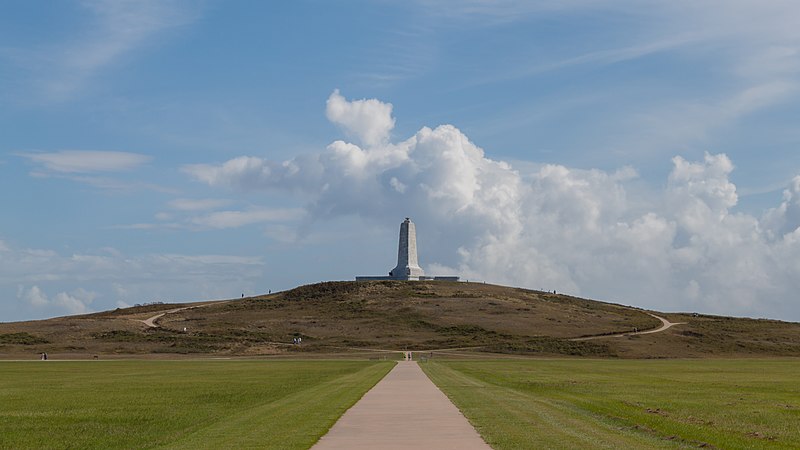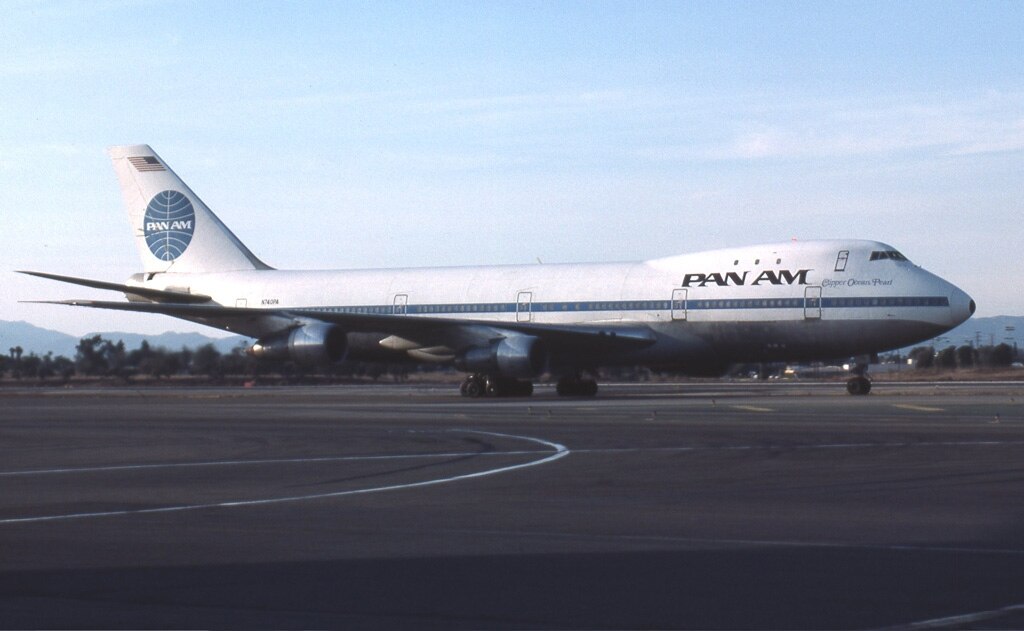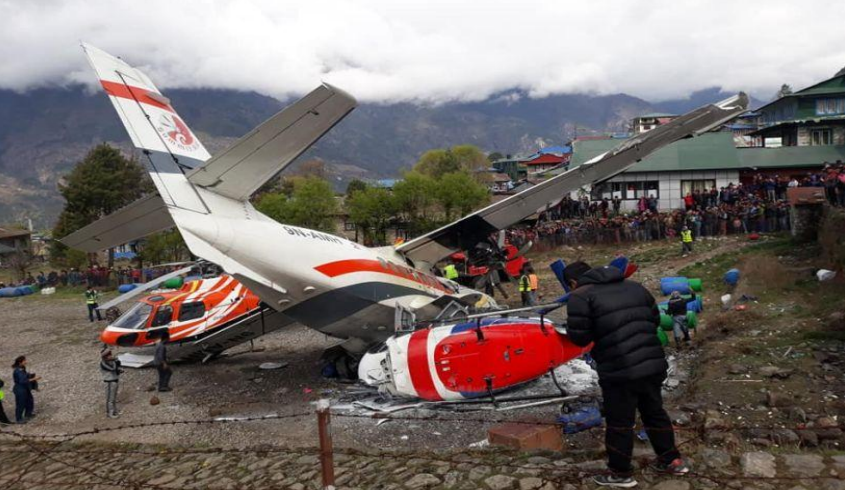Aviation has undergone a remarkable transformation since the era of the Wright Brothers. From humble beginnings to reaching the skies and beyond, the evolution of aviation has been nothing short of extraordinary, as we have seen the introduction of bizarre aircraft such as the Caspian Sea Monster, the all-metal monster the Kalinin K-7, and other sleek aircraft that are used for commercial and private purposes.
Some commercial airports now offer more than sixty million seats annually, and airlines around the world are competing to become the largest airlines. In this article, we will try to uncover the pivotal moments, and groundbreaking innovations that has seen aviation as a luxury that very few have been able to afford being accessible to around 20% people in the world.

Photo: Kip Robinson | Wikimedia Commons
The first propulsion and evolution of the piston engines
In 1903, the Wright brothers utilized a four-cylinder in-line piston engine, adapted from automotive designs, to power their pioneering flight. This engine produced 12 horsepower and weighed approximately 174 pounds, resulting in a modest power-to-weight ratio.
By 1908, the French company Gnome revolutionized aviation propulsion with the introduction of the rotary piston engine. This design arranged cylinders radially around a crankshaft, significantly enhancing the power-to-weight ratio. However, the engine’s constant rotation increased drag and made aircraft handling more challenging.

Photo: Valder 137 | Wikimedia Commons
During World War I, the rotary engine’s superior performance led to its widespread adoption in military aircraft. Post-war, the focus shifted to improving engine efficiency and reliability. The 1920s and 1930s saw the development of more advanced radial and in-line engines, culminating in powerful models like the Pratt & Whitney R-4360 Wasp Major. This 28-cylinder radial engine, introduced in the 1940s, delivered up to 3,500 horsepower and powered large aircraft such as the Douglas DC-6.
The evolution of piston engines can be summarized as follows:
- Early Designs (1903-1908): Adaptation of automotive engines with limited power and high weight.
- Rotary Engines (1908-1918): Introduction of rotary designs offering better power-to-weight ratios but with handling challenges.
- Advancements (1920s-1930s): Development of more efficient radial and in-line engines, improving performance and reliability.
- Peak Performance (1940s): Creation of high-powered engines like the Pratt & Whitney R-4360 Wasp Major, enabling larger and more capable aircraft.
These advancements laid the foundation for modern aviation, leading to the eventual transition to jet propulsion in the latter half of the 20th century.
The evolution in aircraft materials
The first powered, controlled flight (the Wright Flyer) was constructed primarily from wood, fabric, and metal wires. Spruce and ash woods formed the framework, while a finely woven cotton cloth covered the structure. A lightweight 12-horsepower gasoline engine powered the aircraft.

Photo: Wright Brothers | Wikimedia Commons
The Ford Tri-Motor, the first passenger plane, was built from aluminum. This advancement led to more circular airframes and wings composed of multiple metal sections bolted together. Control surfaces like ailerons, rudders, flaps, and elevators were crafted from aluminum alloy frames; in some models, such as the Douglas DC-3, these surfaces were covered with fabric.
As aviation progressed, manufacturers incorporated metals like steel and titanium to enhance heat resistance, corrosion resistance, and structural strength. The Boeing 747 exemplifies this approach, being primarily constructed from aluminum with select components made from other metals and alloys.

photo: Jon Proctor |Wikimedia commons
In the early 1970s, France and Germany initiated a collaborative project that marked the beginning of composite material usage in aircraft structures. Composites, combining materials like carbon fiber and epoxy resin, offered significant weight reductions and increased strength. Modern airliners, such as the Boeing 787 and Airbus A350, extensively utilize composite materials, resulting in improved fuel efficiency and performance.
The Wright Brothers’ Impact on Future of aircraft developments
In December next year, aviation will mark 120 years since powered human flight. However, there were predecessors to the Wright Brothers, too. 19th-century engineer George Cayley studied flight principles while Jean-Marie Le Bris attempted flight using a horse-towed glider in 1868. Clement Ader’s steam-powered aircraft ‘Eole’ briefly lifted off in 1886.

Photo: Wikimedia Commons
If we’re to go back even further, flight interest dates back millennia. Greek mythology speaks of Icarus, while ancient Indian texts mention flying palaces. n Hindu mythology, there’s the figure of Garuda, a deity who is a mount of Lord Vishnu. [ A local story: When the first pilot landed an aircraft in Nepal, people thought the pilot was a Garuda and bowed Infront of him.] The 9th-century inventor Abbas ibn Firnas designed a glider, described as flying “faster than the phoenix.” Leonardo da Vinci, in the 16th century, analyzed bird flight and sketched flying machines, some of which resembled rotorcraft.
Wright Brothers’ Breakthrough
In 1903, the Wright brothers achieved the first sustained powered flight, lasting 12 seconds over 37 meters. By 1905, their Flyer III flew for 39 minutes, covering over 38 km. In 1908, their aircraft was adapted for passengers, marking the first airplane passenger flight. The brothers also gave flight lessons to military personnel.

Photo: Wikimedia Commons
And it was military that took aviation forward as World War I spurred rapid aviation advancements. Italy pioneered aerial reconnaissance in 1911; the war saw aircraft used for combat and bombing. Hugo Junkers introduced the all-metal airframe in 1915, influencing future designs.
Around the same time, St. Petersburg-Tampa Airboat Line, provided the first passenger service in 1914. Five years later, the first transatlantic flight pilot Charles Lindbergh crossed the pond in 1927. A decade later, the Dornier Do X was built, the largest aircraft of its time, seating up to 169. [Dornier’s Do-228 is currently used in altiports such as Lukla Airport.]
Rise of Modern Airliners
The Douglas DC-3, introduced in 1936, was the first profitable passenger aircraft, with over 11,000 units built. This aircraft had a capacity of merely 32 passengers [14 passengers if the aircraft was equipped with beds]. The introduction of the jet age began in 1952 with the de Havilland Comet, followed by the Boeing 707 and with the introduction of the widebody aircraft – the Boeing 747, launched in 1970, revolutionized air travel with increased capacity and lower fares.

Photo: Ermell | Wikimedia Commons
However, there are several other distinct aircraft that have been a part of the evolution of aircraft:
- The Airbus A380, the world’s largest passenger plane, debuted in 2005 but struggled due to changing market trends.
- Concorde, launched in 1976, became the most famous supersonic passenger aircraft, though Tupolev Tu-144 was the first passenger aircraft to break the sound barrier.
- High costs led to the retirement of Concorde 2003; new projects like Boom Supersonic’s Overture aim to revive supersonic travel.
- Scaled Composites Stratolaunch became the first aircraft with two fuselage, and also holds the distinction of being the biggest aircraft ever made.
- Future advancements include hydrogen and electric aircraft, with Airbus targeting a hydrogen-powered jet by 2035.
World War Era: A Catalyst for the evolution of pilot training
Flight training has transformed alongside technological advancements, moving from an exclusive privilege that was accessible to military personnel to a structured system where people can have a private pilot’s license, thus allowing greater accessibility to a broader population.

Photo: Imperial War Museum | Wikimedia Commons
Undoubtedly, it was the World War I that introduced large-scale aviation training. The second of the great war that followed had standardized training methods and condensed programs. After the introduction of the jet age, there was an increased demand for pilots and refined training. After the liberalization of aviation, taking to the skies for travel, work, and leisure became common and helped common people beyond military backgrounds, to become pilots.
World War II Training Models
Before the 1970s, military-trained pilots dominated commercial aviation. Training during WWII followed a structured approach:
- Selection Process: Focused on mathematics, reasoning, and IQ tests.
- Ground Training (8 weeks): Covered aerodynamics, navigation, and theory.
- Basic Flight Training (10 weeks): Conducted using aircraft like the PT-17 and Miles Magister.
- Advanced Training: Introduced combat maneuvers and high-performance aircraft.
- Flight Hours: Pilots logged 200–300 hours over nine months (reduced to 30 weeks during wartime).
- Early Simulators: The Link Trainer, developed in the 1920s, helped pilots learn instrument flying and cockpit familiarity
The Introduction of Crew Resource Management
By the 1970s, airline crashes due to communication failures led to the development of CRM – a notable case study of which was the crash of United 173 (1978), when A crew fixated on a landing gear issue, ignored fuel levels, leading to a crash.

In 1981, FAA, NASA, and United Airlines collaborated to enhance cockpit communication and decision-making by the introduction of Crew Resource Management (CRM). CRM eliminated structured, rigid command hierarchies, encouraging input from all crew members and now a global requirement in pilot training.
Advanced Qualification Programs (AQP) & Multi-Crew Pilot License (MPL)
A decade after the introduction of CRM as standard practice, the United States introduced Advanced Qualification Programs (AQP) which allowed training that was centered at focusing on proficiency rather than following rigid standards. It had a combination of maneuver validation and scenario-based evaluations in simulators.

Photo: US Air Force | Wikimedia Commons
Unlike traditional U.S. training, European and Asian pilots start in multi-crew environments early, making airline transitions smoother. One of the nuances of training as multi-crew pilot license (MPL) was explained by Jack Herstam, an airline pilot:
After performing their initial solo, students who learn under this methodology work as crews (in small general aviation training aircraft) and learn how to run checklists and coordinate as a team from a very early stage in training. An instructor occupies the right seat, while the flying student works as a crew with their student colleague in the backseat (the monitoring pilot). This allows for a more seamless transition to their turbine type ratings, which require a multi-pilot environment.
U.S. pilots must log 1,500 hours before airline employment, whereas MPL programs require fewer flight hours with extensive simulator training.
Rise of Airline Cadet Programs
Historically, U.S. airlines recruited ex-military pilots, but by the turn of the millennium, civilian training pipelines became an integral part of aviation. Airlines like JetBlue and American Airlines launched cadet programs, which provide structured training and mentorship but rarely covers full tuition.

The Introduction of Iconic Passenger Jets and how airline seats changed
In the early days of aviation, passenger seats were simple wicker chairs fastened to the aircraft floor. By 1930, the Aluminum Company of America introduced lightweight aluminum seats, a material still used in seat frames today. The Douglas DC-3, introduced in 1936, featured rubber-covered foam seats for enhanced comfort.
The 1940s saw airlines experimenting with convertible seats that transformed into beds for overnight flights. Boeing’s 377 Stratocruiser, launched in 1949, included a lower deck lounge accessible via a spiral staircase and overhead drop-down beds.

Photo: SAS Scandinavian Airlines | Wikimedia Commons
The introduction of the Boeing 747 marked a significant shift in seating design. It featured the multiplex system, offering attendant call buttons and reading light activation, and provided audio for movies through pneumatic tubes in the armrests. The 747 also introduced an upper lounge for first-class passengers, setting a trend for onboard lounges.
In recent years, seat dimensions have decreased. The pitch, or distance between seats, has been reduced from 31-32 inches to 30 inches, and seat width has narrowed by approximately 2 inches. Some airlines offer seats as narrow as 16.7 inches, compared to the average first-class seat width of 21 inches.

Photo: NinjaSnipr | Wikimedia Commons
To enhance passenger comfort, airlines have introduced premium economy seats with features like hard shells that allow reclining without disturbing passengers behind. Lufthansa’s upgraded premium economy seats, for example, include amenities such as three-point seatbelts, wireless charging armrests, neck pillows, USB ports, noise-cancelling headphones, and large screens with Bluetooth connectivity.
The Evolution of Airline safety
Despite high-profile incidents like the Boeing 737 MAX crashes in 2019 and 2020, the industry’s commitment to safety has led to significant improvements.
Statistically, the likelihood of a fatality per billion kilometers traveled by plane is 0.003%, markedly lower than that of trains at 0.27% and automobiles at 2.57%. This translates to a 1 in 29 million chance of dying in a plane crash in regions with stringent aviation regulations, such as North America and Europe.

Photo: NTSB | Wikimedia Commons
The impact of these measures is evident in the declining number of fatal air crashes. In 1959, the United States experienced 40 fatal crashes per million flights. By 1969, this figure had decreased to fewer than two per million flights, and today, it stands at approximately 0.1 per million departures.
Contributing to this downward trend are technological advancements such as:
- the introduction of reliable jet engines
- sophisticated navigation systems
- Enhanced pilot training, particularly through state-of-the-art simulators
- meticulous supervision of aircraft manufacturing processes.
One of the most famous crashes in aviation history was that of Concorde- the aircraft that touched the speed of sound. However, it has a quarter of a century since such a crash took place, and it had been sixteen years since a crash like that between an American Airlines plane and an army helicopter killed more than sixty passengers in the United States.

Photo: Government of Nepal
Aircraft Accident Investigation Commission, 2019
Even in a nation like Nepal, which houses Lukla Airport, STOLport (a Short Take off and Landing Airport) which is dubbed to be the most dangerous in the world, no fatal crashed have been observed for over six years.
Conclusion
Wright Brothers’ first flight led us to the marvels of the Jet Age and soon private aircraft that one could park is the garage of our own houses might become the norm. The future of aviation, however, is poised on the cusp of space exploration and advanced aeronautics. It promises to continue the legacy of the myths og Garuda, of Icarus to travel beyond the Earth and reach for, quite possibly, other planets.
Frequently Asked Questions
How did the Wright Brothers contribute to the evolution of aviation?
The Wright Brothers made history with their first powered flight in 1903, laying the foundation for modern aviation with their pioneering aircraft design and engineering principles.
What were some significant milestones in commercial aviation?
Significant milestones include the establishment of the first commercial airlines, the introduction of passenger jets like the Boeing 707 and the Concorde, and the development of air travel infrastructure.
How did military conflicts influence the advancement of aviation technology?
The outbreak of World War I and II propelled aviation into the forefront of technological innovation, with advancements in aerodynamics, engine technology, and navigation systems driven by the demands of military aircraft development.
What impact did the advent of jet propulsion have on air travel?
The advent of jet propulsion, particularly with the introduction of aircraft like the Boeing 707 and the Douglas DC-8, revolutionized air travel by enabling faster and more efficient flights, making long-distance travel more convenient and accessible to the masses.
How has space exploration extended the boundaries of aviation?
Space exploration represents the ultimate extension of aviation, transitioning from aeronautics to astronautics. It includes significant milestones like human spaceflight and the ongoing quest to explore beyond Earth’s atmosphere.
What can we expect from the future of aviation?
The future of aviation promises continued innovation, with advancements in technology leading to more efficient, sustainable, and possibly autonomous aircraft. The exploration of space also continues to push the boundaries of what is possible in aviation.
